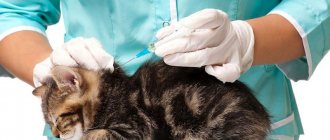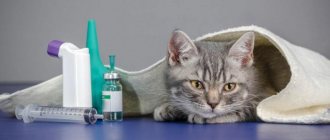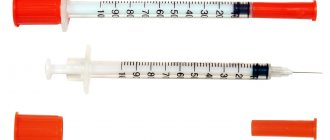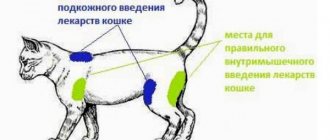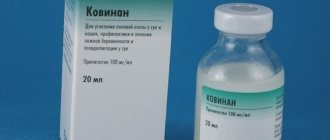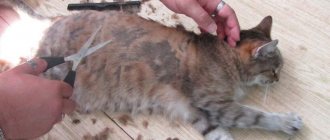Every pet owner wants to see their animal in good health. But, unfortunately, like all other representatives of the fauna, they can also get sick. At the same time, for treatment, many veterinarians prescribe medications in the form of injections, which are in no way inferior in effectiveness to tablets, or even surpass them.
Experienced specialists can easily inject a cat in the thigh due to the specifics of their work. But pet owners, in turn, should also know how to do this procedure correctly and safely.
The need for injections
First of all, it is worth understanding that a prick and an injection are the same thing. That is, this means administering the drug by piercing the skin and tissue of a certain type (muscle). Almost every cat owner has had to take their pet to a veterinary clinic and see how this procedure is performed. Injections can be given on a regular basis (scheduled vaccinations) or carried out after the tailed animal has been injured - in order to maintain its immune system.
As we are all well aware, it is often impossible to recover without medications. It’s the same with pets: without the intervention and help of the owners, the disease will not go away. And since injections are highly effective in treatment, it is worth learning how to inject a cat in the thigh.
As a result, this will save not only time, but also money. In addition, the procedure can be performed urgently and thereby save the animal’s life.
PRP therapy
PRP stands for platelet-rich plasma. Platrlet rich plasma. Platelets are responsible for the formation of blood clots - blood clots that can clog damaged blood vessels. Platelets also actively participate in the processes of cleansing wounds of unnecessary proteins and stimulate the activity of fibroblasts. The latter are responsible for the production of collagen and elastin, which are the basis of connective tissue.
PRP therapy is injections for joint pain that have a number of advantages:
- do not cause allergies or side effects;
- rarely lead to the development of complications; (hormones);
- vitamins;
- do not transmit infection..
These advantages are due to the use of the patient’s own blood, which is completely compatible with body tissues. To improve the effect, plasma administration can be combined with hyaluronic acid preparations.
Efficacy of intramuscular injection
Why do many experts recommend intramuscular injections for pets? Any pet owner may have a similar question. This need is due to pure physiology: the fact is that muscle tissue is penetrated by many blood vessels. And if solutions are injected into it for medicinal purposes, they are almost instantly absorbed into the bloodstream.
Moreover, you need to prick exactly in the back of the animal’s thigh. You can, of course, limit yourself to a subcutaneous injection (this is an injection into the cat’s withers), but in this case a strong reaction and pain syndrome may occur. In addition, the medicine takes much longer to dissolve from the subcutaneous tissue, which is why infiltrates may begin to develop.
Muscles are distinguished by the fact that they have a network of lymphatic and blood vessels. Therefore, nothing interferes with the absorption of injected drugs. Learning how to give injections is not difficult, but you should know a number of important rules. Actually, all this will be discussed further.
How to give an intramuscular injection
Although it is easier to give a subcutaneous injection, there are a number of medications that the instructions prescribe to be administered exclusively intramuscularly. This is explained by the fact that some drugs do not disperse well when injected subcutaneously or are irritating to the tissue.
Oil solutions and suspensions are injected intramuscularly when it is necessary to localize a certain amount of the drug in one place. Gradually dissolving, they provide a certain level of therapeutic substance in the blood for a long time - they have a prolonged effect.
Preparation for injection is the same as for subcutaneous administration. It is better to inject into the thigh area, because it is more fleshy and less likely to damage internal structures.
For intramuscular injections in cats, an insulin syringe is well suited. The diameter of its needle is smaller, so there is less tissue injury, and the short length will not allow it to be inserted too deeply into the tissue. This option is applicable when administering most medicinal solutions, with the exception of thick oil-based solutions, which are difficult to pass through the thin needle of an insulin syringe.
It is advisable to give an intramuscular injection to a fixed animal. The injection is more painful than the subcutaneous injection, so the cat may jerk or escape during the procedure.
Preparatory stage
Since an injection for pets is somewhat reminiscent of an operation, then, like any procedure, it should only be carried out under sterile conditions! In general, an intramuscular injection (we already know where to inject an injection into the thigh of a cat) is not difficult, but everything must be done correctly. Otherwise, you should not hope for effective treatment.
In addition, it is important to use only those medications that are prescribed by a veterinarian, and not on the advice of a neighbor - they say, he treated his cat this way. In each specific case, diagnosis is important, and only after it has been carried out can the doctor prescribe the necessary course of treatment. Therefore, it is better not to self-medicate and leave the choice of drugs to a specialist.
It is worth considering that cats feel like masters in their own territory, and if they are scared or in an aggressive state, then the owner runs the risk of being bitten or scratched.
Chondroprotectors
Such drugs are taken for degenerative-dystrophic diseases of the joints and spine to protect hyaline cartilage. The process of destruction of cartilage tissue during arthrosis and arthritis is progressive and irreversible. It can be slowed down with the help of chondroprotectors, which are especially effective when they “directly hit” the joint cavity. They improve local metabolism and nutrition of intra-articular tissues, and most importantly, stimulate the synthesis of their own collagen.
Collagen is the main component of cartilage, which performs a protective function. Thanks to the cartilage coating, the articular surfaces of the bones slide rather than rub, and movement does not cause pain. Most often, doctors prescribe Alflutop; the frequency and duration of the course is determined individually. The minimum number of injections is 5.
Syringe
You should take the choice of a syringe seriously, because if something happens, you can give the animal an infection. Just as in the case of people, injection instruments for pets must be new (fortunately, they are inexpensive, because they are, in fact, consumables, and for one-time use) and must be sterile.
The choice of a syringe for injecting a cat intramuscularly largely depends on the type of drug and its dosage. Often, most veterinarians recommend the use of insulin syringes. They have a thin and short needle, due to which minimal discomfort will be caused to the animal. This is the best solution for kittens!
However, if the dosage prescribed by the veterinarian exceeds 1 ml, it is worth purchasing a 2 ml instrument. It also does not have a thick needle, but this is quite enough for injections with solutions with particles. However, an even larger syringe may be required. Then it is better to inject with a large needle than to prick several times with a small one.
In any case, here it is worth relying on the recommendations of a veterinarian. Only he has the right to decide which drug and syringes to use in each specific case.
How to give a hypodermic injection to a cat
For subcutaneous administration, it is better to use syringes with a volume of 2 or 3 ml. If you need to inject a medicine in a dose of less than 1 ml, use a syringe to inject insulin, replacing the needle on it. The needle from an insulin syringe is too thin and short for subcutaneous injection into a cat, so it is better to take a needle from a 2 gram syringe. When administering drugs subcutaneously, adhere to the general rules for preparing for injection given above. An injection under the skin is often made in the withers area; this area is less sensitive to pain.
A drug
The dosage prescribed by the veterinarian, including his recommendations, must be strictly followed. When thinking about how to properly give an injection to a cat, it is also worth considering that some medications can be placed both in the withers and in the muscle, while others can only be placed in a strictly defined place. In this case, the volume of the drug is always indicated in cubes, but this is equivalent to millimeters.
It is also important to carefully read the instructions for the medicine. Some of them need to be stored only in the refrigerator, others are designed for one-time use, and others even require dilution with water.
Preparing the animal
Injections for cats are an operation, and any operation must be carried out in sterility. For the procedure you will need the drug itself, sterile syringes, the pet itself and strong nerves of the owner. If you are very worried or the animal is too violent, and the matter can be tolerated, it is better to take your pet to a professional.
As a rule, cats feel like masters in their territory. Frightened or aggressive, they can easily grab their owner’s finger or scratch them. Therefore, you need to give the cat an injection quickly and with a steady hand.
The dosage of the drug and the recommendations of the veterinarian should be strictly followed. The volume of drugs is sometimes written in cubes and here it is worth knowing that this is the same as milliliters. Be sure to read the instructions for the drug. Some of them can be stored, and only in the refrigerator, others are designed for one time use, and others need to be diluted with water.
You also need to pay attention to where to inject the cat. Owners at home can do two types of injections on their own: subcutaneously and intramuscularly. A subcutaneous injection is usually given in the withers, and an intramuscular injection in the thigh. These names can also be found in an abbreviated form in a doctor’s note, as “s/c” and “i/m”.
It is also important to know how to choose injection syringes.
- “Insulin” syringes are convenient for intramuscular injection. Their needle is very thin and small in size, which is good if the patient is a kitten. However, they are not suitable if you plan to administer a dose of more than 1 ml. They are also not suitable for introducing thick oily solutions, as they clog easily. In this case, 2-3 ml syringes are used.
- To administer the injection subcutaneously, syringes suitable for the dose of the drug are used. A cat is a small animal, and it is better to choose those with a thinner needle. You can even move a thinner needle to a syringe of the desired volume, if it fits. But this must be done with sterile gloves.
One syringe for one injection. Do not store syringes, touch or bend the sterile game with your fingers before insertion
To draw the drug into a syringe, you need to open the ampoule or bottle. Then lower the needle into the liquid and pull the piston. Beginners in this business need to take a few notches more liquid into the piston than necessary. This is done because then the air is squeezed out of the syringe, with which a couple of tenths of a milliliter of volume will be lost. In order for the bubbles to collect at the very top, lift the syringe with the needle down, and then click it with your finger several times. Hands must be washed thoroughly!
Important Rules
Before proceeding directly to the procedure, owners should study a number of important rules, or even, rather, requirements:
- It is prohibited to mix drugs in one syringe unless directed by the doctor.
- The procedure itself should be performed only with clean hands. The sterility of not only the instrument itself, but also its needle is also important.
- If the ampoule contains a cold drug, you should first warm it up in your palms to body temperature.
- After drawing the medicine into the syringe, it is necessary to lift it up with the needle and release all air bubbles by pressing the piston. In this case, a few drops of solution will be squeezed out - a necessary measure.
We now know where to give a cat an intramuscular injection, but as for kittens, there are no special rules in this case.
It’s just that the owners should act more carefully, since the scope for manipulation is limited. The only difference is not in the method of administration of the drug, but in its dosage.
Basic rules for performing an injection
When injecting medication into a muscle, it is important to know the basic rules of this procedure:
- The drug should only be injected into a relaxed muscle! If the muscle is tense, the animal will experience severe pain when injected, and the medicine will not be able to distribute normally into the tissue. In addition, there is a high probability of muscle tears and severe hemorrhages. To prevent the animal from straining its paw too much, the limb must be slightly bent before inserting the needle, while stroking it.
- It is necessary to thoroughly examine the skin at the site where the needle is supposed to be inserted. It is forbidden to give an injection if there are scabs, ulcers, or other damage on the skin . It is also not recommended to give injections to animals with a severe flea infestation. First, you should treat your pet for ectoparasites.
- Of course, you must use only sterile needles and syringes.
- The medicine is preheated to a temperature of 37°C.
- Not all points on the thigh can be injected! Above we have already indicated the place of drug administration.
- When inserting the needle, it must be directed straight, without deviating from this direction.
And one more important rule - you are allowed to insert a needle into a cat’s muscles a maximum of one centimeter! Therefore, we recommend using an insulin syringe whose needle has the same length.
Calm, just calm!
Before the procedure, the animal should be calmed, because the muscle should be relaxed. To do this, you should take your pet in your arms and bring it into the appropriate state with affection. The area before the injection does not need to be treated with alcohol, but it is advisable to do so after the injection. At the same time, the surface of the skin itself should be healthy, without wounds.
It’s not just the pet that needs preparation—cats sense their owner’s mood very well. For this reason, if fear or severe anxiety has crept into your soul, you should not approach an animal with such a “load.” To begin with, you should calm down and start preparing for the procedure, and only after that go to catch your pet.
How to give an injection to a cat? It is impossible to prepare the pet itself for the procedure, so it is important to create comfortable conditions so that the injection does not result in severe stress. The best option is to stay alone with the cat, but often the injection is not always successful. Therefore, you have to hire an assistant to hold the animal.
Permitted drug administration sites
There are many large nerve trunks running through the thickness of the femoral muscles, and therefore you should not mindlessly stick a needle. This can lead to the development of painful shock and even the death of the pet due to it. Choosing the injection site is easy. First you need to mentally make a projection, drawing a line between the knee and hip joint. The injection should be made in the middle of this line, closer to the knee joint.
Above is a large trunk of the sciatic nerve, which if hit will lead to very serious consequences! In addition, in approximately the same place there are many large blood vessels, which are also very undesirable to hit with a needle.
Intramuscular injection technique
An injection into the muscle fibers is a rather painful procedure for the animal. In addition, some drugs themselves can cause discomfort. Typically these include antispasmodics, antibiotics, and a number of vitamins. It is for this reason that you should calm your pet, because the needle may not even pierce the tense muscle.
Most likely, the animal will resist. Therefore, it is worth preparing the place for the procedure - a flat and hard surface where the “patient” can be securely fixed. In any case, you will need an assistant, because the cat will react unexpectedly to the injection itself: at the most inopportune moment, the pet may jerk sharply and escape.
The entire algorithm for how to inject a cat is as follows:
- One of the participants in the procedure holds the pet firmly, the other needs to securely grab it by the back paw. The injection itself should be done in the back of the thigh - this is where it is the most “meaty”. In this case, you need to prick when the animal relaxes its paw and does not try to pull it out.
- The needle should be inserted perpendicular to the bone so that it enters the muscle and not under the skin. The depth of penetration is no more than 10 mm (for a kitten - 5 mm).
- The process of administering the medicine should be carried out slowly and smoothly (do not press the piston sharply). The more drug should be administered, the slower it should be done. It takes about 3-4 seconds for 1 ml. In this case, an injection of no more than 1.5-2 cubic meters is allowed in one place.
- After the injection is made, the needle is removed and the animal is released. Sometimes it is better to do this to everyone at the same time, otherwise a disgruntled pet may cling to someone in order to take revenge on the “offender.”
How to give a cat an injection if a course of several procedures is prescribed? In this case, injections are carried out in both hind legs alternately - first in one, then in the other, etc. And after the procedure is completed, you should massage the injection site - this promotes rapid absorption of the medicine.
If the injection is done correctly, the procedure usually goes unnoticed for the animal. However, in some cases there may be complications or rather consequences.
How to give an injection at the withers
Before the injection, caress and stroke the animal. Speak calmly and friendly. Hold the cat with the forearm of your right hand, pressing it lightly. If you are injecting with an assistant, then have him press the shoulders with the head with one hand, and the backside with the other, to the surface on which the animal is lying. Take the syringe with the prepared medicine with your right hand, and form a skin fold with your left. To do this, pull the skin with your left hand.
Pierce the skin with a confident movement, aiming the needle under the base of the fold and parallel to the body. The needle is inserted 1 - 2 cm long, not perpendicular to the fold, but at an angle. The skin in the withers area is quite dense and to pierce it you need to apply some force. After the puncture, administer the medicine; the speed of administration for subcutaneous injections does not matter.
Be careful not to puncture the fold of skin all the way through, otherwise the medicine will leak out from the opposite side and you will have to repeat the injection.
Without releasing the fold, remove the needle and syringe. The injection site can be lightly massaged so that the medicine spreads evenly under the skin and does not flow out through the injection hole.
In one subcutaneous injection, significant volumes of drug solutions can be administered - from 30 to 60 ml, depending on live weight.
Lameness
Sometimes an injection into the thigh of a cat can cause the pet to limp, which is also normal. Particularly sensitive individuals may even harbor a grudge against such interference from the owner. However, there is no need to worry about this.
A cause for serious concern may be when a pet drags a limb or lameness does not go away after a day. This indicates that a nerve has been affected. This condition requires the intervention of a veterinarian, and the sooner the better for the animal. Therefore, after the procedure, you should carefully monitor your pet’s condition.
Useful tips
To inject your cat yourself and avoid complications, you need to adhere to the following recommendations:
- for injections, you should use only a sterile syringe, which must be disposed of after the procedure;
- the needle must not be touched with hands, otherwise it must be replaced;
- Before carrying out the procedure, it is better to fix the pet in a motionless state, leaving only the injection site of the syringe open (you can use a harness, blanket, sheet and other accessories) or invite someone from the side to hold the cat;
- as a rule, injections are made into an intact area of the skin, so if the animal has any skin disease, you must first clarify this issue with a veterinarian;
- there is no need to disinfect the injection site of the syringe, but the owner must first wash his hands with soap and treat them with an antiseptic;
- if the doctor has prescribed injections every day or several a day, it is best to give injections to the paw alternately - right and left or front and back, in order to avoid severe trauma to the cat’s tissues and allow them to heal;
- oil-based medicine should not be allowed to enter the bloodstream; You can make sure that the needle has not entered a blood vessel by slightly pulling the plunger towards you after inserting the syringe - the absence of blood in the solution indicates that the vessels are not affected, and you can continue the procedure;
- You cannot administer more than one drug at the same time in one syringe, unless authorized by a specialist.
To support a mustachioed pet during the procedure, as well as before and after it, you need to talk to it as gently as possible, stroke it, and calm it down. At the end of the manipulations, you should give the cat something tasty.
Every owner can give a cat an injection on their own, the main thing is desire. It’s good if the skill isn’t useful, but mastering it won’t hurt at all.
Cone
Another complication that may appear after an injection is given to an animal is the formation of a lump at the injection site. There are several reasons for this problem:
- allergic manifestation to the administered drug;
- individual reaction of the animal’s body;
- the injection into the feline's thigh was given incorrectly.
In this case, it is necessary to monitor the condition of the “patient”. And if within two days the dynamics do not change in a positive direction, you should go to the clinic. This is especially true in cases where the injection site has become hot and red. Then a trip to the veterinarian cannot be postponed, and the animal must be taken for examination as soon as possible.
Often the formation of a lump is associated with the accumulation of a purulent mass, and this is already the focus of a dangerous inflammatory process.
Carbon dioxide (carboxytherapy)
The effect of carboxytherapy is based on the property of carbon dioxide to cause oxygen starvation in tissues. Gas injections are given through a special device, and after the injection the body strives to enrich the joint with oxygen, increasing its blood supply. Metabolism accelerates sharply, and much more nutrients are supplied to damaged structures. In a matter of minutes, carbon dioxide leaves the joint cavity, and the effect remains for a long time.
Attention! The advantage of this unique technique is the absence of side effects, since CO2 is a natural element, a product of metabolic processes.
Carbon dioxide treatment was developed by Czech specialists from the city of Karlovy Vary, where the famous sanatorium is located. It has been successfully treating diseases of the musculoskeletal system for more than a century.
The procedure is ongoing
Without a doubt, the injection is unpleasant for animals and causes them considerable discomfort. Unfortunately, situations may arise when the injection must be given continuously over a certain period of time. In this case, it is worth taking care of maximum comfort for the pet in order to avoid prolonged stress.
It will not be possible to train your pet to endure pain, but there is an opportunity for associative perception:
- Injections into the cat's thigh should be done at the same hours and in the same environment.
- The pet must be in a calm state of mind.
- Immediately before the procedure, you should begin to establish contact with the animal: stroke it, caress it.
- After the injection, be sure to praise your pet and give him his favorite treat.
Following these recommendations will help the animal endure discomfort more patiently and be calmer.
Advantages
- The drugs dissolve very slowly, up to 12 months.
- They have a local effect on all joint tissues.
- Almost do not enter the systemic circulation and do not affect the functioning of internal organs.
- Thanks to the previous point, they can be used in patients with severe concomitant pathologies, when treatment with other methods is unacceptable.
- Intra-articular injections help avoid surgery.
- After the procedure, no rehabilitation is required; the doctor can only apply a tight bandage and warn against excessive physical exertion.
In what cases are hormones prescribed?
In the later stages of arthrosis of the hip joint or any other, when pain almost always bothers the patient and painkillers do not help, a stronger remedy may be prescribed. This is an emergency treatment measure that can quickly relieve pain and improve well-being. Unfortunately, this coin also has a downside, especially if you resort to this method more often than necessary.
Kenalog, diprospan and other corticosteroid drugs quickly stop inflammation, eliminate edema and swelling. However, they do not cure arthrosis at all, do not restore nutrition to the cartilage and do not improve the condition of the joint. This is only an ambulance - a powerful blow to the body, especially if you resort to such treatment for osteoarthritis too often.
No organism can withstand frequent injections of hormonal drugs.
Indications
- osteoarthritis;
- arthritis;
- bursitis;
- synovitis;
- tendinitis.
Joint diseases are very common, especially among older people. If you are one of them, or the time has come to repeat the course of treatment, call us. Our center employs high-level specialists with extensive experience, making patients feel comfortable and confident. If necessary, you will be prescribed one or more intra-articular injection procedures and a drug will be selected based on the indications.
